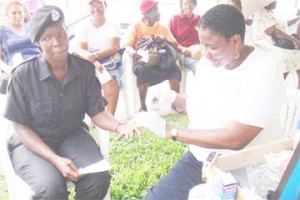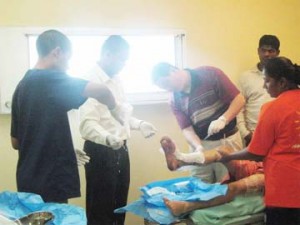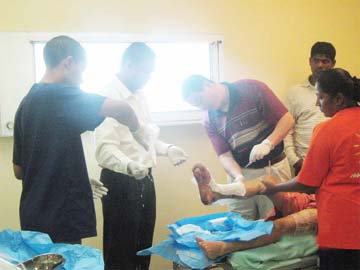– foot care clinic reduces amputations
The increasing public health burden of chronic diseases in Guyana has led to growing recognition of the need to manage them more effectively; diabetes remains a challenge as many new cases emerge annually and many diabetics are not complying with treatment.

It is anticipated that some 50,000 Guyanese would be diagnosed with diabetes over time based on the numbers being recorded, and women are likely to be the majority of patients. Statistics in the health sector show that Guyanese women account for 60 per cent of the 28,000 diabetic patients there are at present.
Every year 5,000 new cases of mainly Type 2 diabetes emerge. The numbers are worrying because the likelihood of developing Type 2 diabetes can be assessed years before the onset of the disease by measuring blood glucose levels.
There is no indication that people are accessing the early screening available, or that more health conscious choices are being made. What is clear is that people are failing to make the lifestyle changes needed to prevent chronic disease such as diabetes, and that the calls for more exercise, greater weight lost and sensible dietary choices are being ignored.
Diabetic patient empowerment is something heath officials are addressing in the hope that those already living with the disease can become more active in the health care process. It has not been easy so far.
While diabetic amputations are down from previous years after peaking over 400 cases in 2007, the health sector is still averaging over 100 every year. There is also a jump in diabetic complications — heart and kidney problems, strokes, blindness and others that patients develop from their chronic condition.
Health Minister Dr Leslie Ramsammy is concerned. He identified diabetes as one of the biggest health problems in the country, but made the point that Guyana has made significant progress in getting an idea of what the prevalence is, as well as the incidence level.
“Women are more vulnerable as the numbers are showing,” he said frankly during a recent interview with Stabroek News underscoring the issue of greater awareness among the female population. He noted that an increased number in women smokers and alcoholic drinkers have added to the risk factors facing females — lack of exercise; failing to manage diet; obesity and a history of diabetes in the family.
There is a low incidence among the children here, Ramsammy said, noting that about 35 children are on register. He said a few children might be missing, but the numbers cannot be many.
Ramsammy said the local health sector is experiencing a paradigm shift in how it communicates with diabetic patients. Health professionals are speaking more directly to persons attending clinics, but they still face the challenge of engaging families.
He identified the family as a core factor in diabetic management, drawing the link between patients and a critical support network. He noted that drugs are not an issue since the sector has a reliable supply of medication that comes at no expense to patients.
While he is encouraged that more diabetics are following up with treatment, the minister said there are many who are still not complying with their medication instructions. He said further that public education campaigns, workshops and community sessions are part of the current strategy to increase awareness of this problem in an effort prevent it.
Aggressive
management
Diabetes is a disease in which the body does not produce or properly use insulin. Insulin is a hormone that is needed to convert sugar, starches and other food into energy needed for daily life. Type 1 diabetes is usually prevalent in children while adults are largely diagnosed with Type 2 diabetes.
Dr K S Kumar, an Indian national, works in the private sector here and the number of diabetic patients he has seen over the years with complications has prompted him to call for more “aggressive management” of the disease.
Asked about the complications, he said patients would show up with kidney problems, nerve problems in the legs, issues relating to blockages in the blood vessels, visions problems and coronary heart disease.
Dr Kumar said there is a critical need for diabetic patients to plan for an aggressive management of diabetes, which he referred to as the Medical Nutrition Therapy (MNT). He described MNT as largely dietary restriction and physical exercise, adding that diabetic patients cannot separate the two.
He said patients can exercise 30-45 minutes a day for five days a week, noting that there are many options such as cycling, walking, swimming and jogging. He said the diet must be low on high ‘carb’ meals and fatty foods. But he emphasized that follow-up checks are very important in diabetic management, adding that a patient should see a doctor once in three months.
“If you are diagnosed with diabetes you are always diabetic, but some people tend to forget and they stop taking medication and quit seeing the doctor believing that everything is okay when it is not,” Dr Kumar added.
The goal, he said, is to substantially slow the progression of the disease with aggressive management of diet, exercise and medicine.
Diabetic foot care

The National Diabetes Programme has various components: preventing the disease, screening persons to identify diabetics, initiating appropriate treatment early, diabetic foot care, and regular follow-ups.
Though it opened two years ago the diabetic foot clinic at the Georgetown Public Hospital (GPH) came into its own a year ago. It has been hailed as one of the most important innovations in responding to diabetic problems, particularly foot problems.
Medical Director at GPH, Dr Madan Rambarran told Stabroek News that one of the main reasons for the clinic was the number of patients presenting with diabetic foot disease. He disclosed that a number of those patients had to get major amputations.
He said the hospital reviewed the problem and started to look at diabetic foot care in a more focused way; addressing issues such as how to get to patients and initiate early treatment and also reduce the incidence of diabetic foot disease.
“You try to delay the onset of the complications, prevent them,” Dr Rambarran said. He said the foot clinic brings together a certain set of best practices in managing the diabetic foot based on the Canadian best practices for diabetic foot care.
According to him the centre is multidisciplinary, in that, many persons from various specialty areas are engaged in caring for the patients. He identified general surgeons, physiotherapists, nurses, orthopaedists saying that they have all been mobilized into the project.
He said Guyana has been innovative in implementing the ’60-second screening tool’, which identifies the patient with a high risk for foot disease and then engages in education. He noted that patients are taught about dressings, how to clean the foot, medications to use and are even provided with footwear to offload pressure on certain parts of the foot.
To date the diabetic foot clinic has seen several thousand patients. Since the clinic opened, hospital officials have been evaluating the impact of admission to ward and according to Dr Rambarran, the preliminary results reveal that there is a reduction in patients being admitted for foot care. He said too that the results also show the beginning of a downward trend in amputations.
Already the programme has started to scale out. Dr Rambarran disclosed that there is now such a facility at West Demerara Regional Hospital and the ministry is in the process of implementing one at the New Amsterdam Hospital. He said the clinics coincide with the surgical post-graduate programme in which all the doctors who are doing the diploma in general surgery are also completing the course in diabetic foot care and wound care. He added that the young doctors are expected to take the diabetic foot programme to clinics across the country.
‘Diabetes is my life
companion’
Living with diabetes involves keeping a close eye on blood glucose levels. Glynis Beaton has been living with it for more than a decade now.
Diagnosed at 24, though she believes it might have been in her blood two years before, Beaton has been in a coma seven times because of her poor management of the disease. She said that on those occasions her diabetes was uncontrolled; she was not controlling her diet, not exercising, and her medication was not working.
She later went on insulin. Beaton told this newspaper that she lived carefree for a while after being diagnosed, but got serious when she became pregnant with her second child. Her first child is autistic, and while no link was made to her diabetes, she theorises that her sugar levels could have been high resulting in brain damage to the baby.
Beaton was blunt about what might have led to her diagnosis saying that her weight problem put her at risk, but she also pointed out that a close relative also had diabetes. She went from a “carefree” person living with diabetes to someone armed with all the information and a pro-active voice in the prevention against diabetes here and in the region.
“After a while you get to understand what is happening. Education is important and it has put me in a position where I am empowered and where I can change the attitude of persons living with diabetes,” Beaton said.
She is a member of the Diabetic Association of Guyana, which was formed in 1969, and which has been functioning ever since though there have been a few lull periods. Beaton became active in the association for a second time in 2006 because of “Norma Howard”. She said that she was encouraged to get active again and to continue what she had started years ago; a passionate involvement in diabetic management.
“Diabetes is my companion for life,” Beaton said while acknowledging that it is challenging to live with the disease. The only fear she has is that of losing her legs. She preaches regular exercise, strict attention to diet and regular follow-ups at the doctor as her key to managing diabetes.
‘They took my leg’
Diabetic Carlyle Moore, 62, grieved for months after his leg was amputated some two years ago. He admitted that he was not complying with his treatment and lost his leg as a result. When this newspaper met him at the foot clinic at GPH he was treating the other leg, which is at risk of also being amputated.
Moore said that he struggled with his diabetes after being diagnosed more than ten years ago and blamed his failure to comply on a lack of support at home. He said his daughter migrated some years ago and left him to “care for myself”.
He recalled that a woman would visit and care for him, but she stopped. Diabetes has been an “eye-opener” according to him. He believes that he could have done more for himself, and now believes that it is too late.
“I ain’t want to lose my other leg,” he lamented. He also complained that the first amputation he had went further up than he had expected.
Low sugar, low fat, high fibre
The diabetic diet should be low in sugar and fat and high in fibre, which is essential in controlling blood sugar levels. The meals should also be well balanced in the quality and quantity of nutrients, according to Director of the Food Policy Unit, Ministry of Health, Norma Howard.
Howard said diabetics as not supposed to quit eating certain foods as is believed, but that they need to focus on portion control. She said that they can eat regular meals, but only a small portion of them.
In terms of how much is allowed, she said “very little or no sugar” and a balance of the various food groups. She stressed food preparation as a key factor in preparing meals for diabetic patients saying that how the meal is prepared is important.
Money is not a major factor in preparing diabetic meals, she said, noting that nutrients are important and that “people often lost it [nutrients] when they prepare everyday meals”. She advised that steamed and stir fry vegetables are more nutritious than those which are stewed down.
She suggested that diabetics aim for five portions of food daily. They must eat regularly: breakfast, a mid-morning snack, lunch, evening meal and a meal at bedtime.
As a guide, she said, that fruits and vegetables should be eaten daily; each meal should have a starchy food such as bread, potatoes, cereals, rice but noted that whole wheat items are better; meat, fish and that eggs should be eaten daily.
She said that diabetics should avoid adding sugar and honey to foods and also avoid sugary drinks. Patients should eat fresh fruits instead of sweets, chocolates and pastries she added.
Howard registered her concern about diabetics who constantly used sweeteners saying that issues have been raised about them. She noted that a diabetic lifestyle is not particularly different from that of any other person because “it is about eating healthy”.

